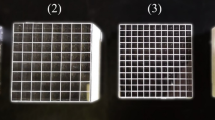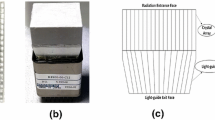Abstract
This chapter examines positron emission tomography (PET) imaging applications using sub-millimeter pixelated cadmium zinc telluride (CdZnTe) detectors. We first discuss the current state of the field and then present recent finds from our own studies. CdZnTe detectors with 0.35 mm and 0.6 mm pitch pixels were fabricated with pixel anodes and coplanar cathode. The characterizations of CdZnTe detectors for PET imaging are analyzed in detail, including 3D spatial resolution, the depth of interaction, charge sharing, timing resolution, and imaging resolution. For positron-annihilated 511 keV gamma ray photons, the single-pixel event profile of the 0.35 mm pitch pixelated CdZnTe detector exhibited a spatial resolution of 0.41 mm FWHM; and the double-pixel charge-sharing event profile had a spatial resolution of 0.52 mm FWHM. Imaging experiments have demonstrated that a PET scanner made of 0.35 mm pitch pixelated CdZnTe detectors can improve the image resolution of PET scanner to 0.5 mm. To narrow the coincidence timing window of CdZnTe PET scanner, a time correction method to the long charge drift time of CdZnTe detector was introduced. To include the coincidence events of the double-pixel charge-sharing events from CdZnTe, an interpolation algorithm for the location of charge-sharing events was developed. Researches indicate that the CdZnTe detector is a promising candidate for sub-millimeter high-resolution PET imaging applications.
Access this chapter
Tax calculation will be finalised at checkout
Purchases are for personal use only
Similar content being viewed by others
References
Phelps, M. E., Hoffman, E. J., et al. (1976). Tomographic images of blood pool and perfusion in brain and heart. Journal of Nuclear Medicine, 17, 603–612.
Ter-Pogossian, M. M., Phelps, M. E., et al. (1975). A positron-emission transaxial tomograph for nuclear imaging (PETT). Radiology, 114(1), 89–98.
Weissleder, R., Ross, B. D., Rehemtulla, A., & Gambhir, S. S. (2010). Molecular imaging – Principles and practice. Shelton: People’s Medical Publishing House.
Muehllehner, G., & Karp, J. S. (2006). Positron emission tomography. Physics in Medicine and Biology, 51, R117–R137.
Cherry, S. R. (1997). MicroPET: A high resolution PET scanner for imaging small animals. IEEE Transactions on Nuclear Science, 44, 1161–1166.
Cherry, S. R. (2004). In vivo molecular and genomic imaging: New challenged for imaging physics. Physics in Medicine and Biology, 49, 13–48.
Beyer, T., Townsend, D. W., et al. (2000). A combined PET/CT scanner for clinical oncology. Journal of Nuclear Medicine, 41, 1369–1379.
Shao, Y., et al. (1997). Simultaneous PET and MR imaging. Physics in Medicine and Biology, 42, 1965–1970.
Moses, W. W., & Derenzo, S. E. (1993). Empirical observation of resolution degradation in positron emission tomographs utilizing block detectors [abstract]. Journal of Nuclear Medicine, 34(suppl), 101P.
Levin, C. S., & Hoffman, E. J. (1999). Calculation of positron range and its effect on the fundamental limit of positron emission tomography system spatial resolution. Physics in Medicine and Biology, 44(3), 781–799.
Wernick, M. N., & Aarsvold, J. N. (2004). Emission tomography the fundamentals of PET and SPECT. Burlington: Elsevier Academic Press.
Bailey, D. L., Townsend, D. W., Valk, P. E., & Maisey, M. N. (2005). Positron emission tomography basic sciences. London: Springer.
Knoll, G. F. (2000). Radiation detection and measurement (3rd ed.). New York: John Wiley & Sons.
Watson, C. C. (2000). New, faster, image-based scatter correction for 3D PET. IEEE Transactions on Nuclear Science, 47(4), 1587–1594.
Markiewicz, P. J., Tamal, M., et al. (2007). High accuracy multiple scatter modelling for 3D whole body PET. Physics in Medicine and Biology, 52, 829–847.
Lewellen, T. K. (1998). Time-of-flight PET. Seminars in Nuclear Medicine, 28, 268–275.
Gu, Y., Matteson, J. L., et al. (2011). Study of a high-resolution, 3D positioning cadmium zinc telluride detector for PET. Physics in Medicine and Biology, 56, 1563–1584.
Zhang, F., He, Z., et al. (2005). Feasibility study of using two 3-D position sensitive CZT detectors for small animal PET. IEEE Nuclear Science Symposium Conference Record, 1582–1585.
Kastis, G. A., Wu, M. C., et al. (2002). Tomographic small-animal imaging using a high resolution semiconductor camera. IEEE Transactions on Nuclear Science, 49(1), 172–175.
Wagenaar DJ (2004) Chapter 15, CdTe and CdZnTe Semiconductor Detectors for Nuclear Medicine Imaging, EMISSION TOMOGRAPHY The Fundamentals of PET and SPECT, Miles N. Wernick, John N. Aarsvold, Elsevier Inc.
Jo, W. J., Jeong, M., et al. (2016). Preliminary research of CZT based PET system development in KAERI. Journal of Radiation Protection and Research, 41(2), 81–86.
Kim, K. H., Hwang, S., et al. (2016). The effect of low-temperature annealing on a CdZnTe detector. IEEE Transactions on Nuclear Science, 63(4), 2278–2282.
Bolotnikov, A. E., Ackley, K., et al. (2015). High-efficiency CdZnTe gamma-ray detectors. IEEE Transactions on Nuclear Science, 62(6), 3193–3198.
He, Z., Knoll, G. F., et al. (1997). Position-sensitive single carrier CdZnTe detectors. Nuclear Instruments and Methods A, 388, 180–185.
Yin, Y., Chen, X., et al. (2014). Evaluation of PET imaging resolution using 350 μm pixelated CZT as VP-PET insert detector. IEEE Transactions on Nuclear Science, 61(1), 154–161.
Yin, Y., Chen, X., et al. (2013). 3D spatial resolution of 350um pitch pixelated CdZnTe detectors for imaging applications. IEEE Transactions on Nuclear Science, 60(1), 9–15.
Cai, L., Lai, X., et al. (2014). MRC-SPECT: A sub-500 μm resolution MR-compatible SPECT system for simultaneous dual-modality study of small animals. Nuclear Instruments and Methods A, 734, 147–151.
Yang, S., Li, M., et al. (2020). Effect of CZT system characteristics on Compton scatter event recovery. IEEE Transactions on Radiation and Plasma Medical Sciences, 4(1), 91–97.
Vernekohl, D., Abbaszadeh, S., et al. (2019). Robust detector calibration for a novel PET system based on cross-strip CZT detectors. IEEE Transactions on Radiation and Plasma Medical Sciences, 3(6), 626–633.
Espagneta, R., Frezzaa, A., et al. (2017). Conception and characterization of a virtual coplanar grid for a 11×11 pixelated CZT detector. Nuclear Instruments and Methods A, 860, 62–69.
Abbaszadeh, S., & Levin, C. S. (2017). Direct conversion semiconductor detectors for radiation imaging. In Semiconductor radiation detectors: Technology and applications (pp. 1–20). Boca Raton: CRC Press.
Spieler, H. (2005). Semiconductor detector systems. Oxford: Oxford Science Publications.
Prokesch, M., Soldner, S. A., et al. (2016). CdZnTe detectors operating at X-ray fluxes of 100 million photons/(mm2.sec). IEEE Transactions on Nuclear Science, 63(3), 1854–1859.
Schlesinger, T. E., Toney, J. E., et al. (2001). Cadmium zinc telluride and its use as a nuclear radiation detector material. Materials Science and Engineering, 32, 103–189.
Yoon, H., Goorsky, M. S., et al. (1999). Resistivity variation of semi-insulating Cd1-xZnxTe in relationship to alloy composition. Journal of Electronic Materials, 28(6), 838–842.
Eisen, Y., & Shor, A. (1998). CdTe and CdZnTe materials for room temperature X-ray and gamma-ray detectors. Journal of Crystal Growth, 184–185, 1302–1312.
Toney, J. E., Schlesinger, T. E., et al. (1998). Elementary analysis of line shapes and energy resolution in semiconductor radiation detectors. Materials Research Society Symposium Proceedings, 487, 193–198.
Barrett, H. H., Eskin, J. D., & Barber, H. B. (1995). Charge transport in arrays of semiconductor gamma-ray detectors. Physical Review Letters, 75(1), 156.
Luke, P. N. (1995). Unipolar charge sensing with coplanar electrodes application to semiconductor detectors. IEEE Transactions on Nuclear Science, 42(4), 207–213.
Luke, P. N. (1994). Single-polarity charge sensing in ionization detectors using coplanar electrodes. Applied Physics L, 65(22), 2884–2886.
He, Z., Knoll, G. F., & Wehe, D. K. (1998). Direct measurement of product of the electron mobility and mean free drift time of CdZnTe semiconductors using position sensitive single polarity charge sensing detectors. Journal of Applied Physics, 84(10), 5566.
Sellin, P. J., Prekas, G., et al. (2010). Performance of CZT wafers grown by vapour phase transport. IEEE Nuclear Science Symposium Conference Record, R01-6.
Zappettini, A., Marchini, L., et al. (2011). Growth and characterization of CZT crystals by the vertical Bridgman method for X-ray detector applications. IEEE Transactions on Nuclear Science, 58(5), 2352–2356.
Llopart, X., Campbell, M., et al. (2002). Medipix2, a 64 k pixel readout chip with 55 micron square elements working in single photon counting mode. IEEE Transactions on Nuclear Science, 49(5), 2279–2283.
Groll, A., & Levin, C. S. (2018). Calibrations of the integrated circuit readout for a high resolution preclinical CZT PET imaging system. IEEE Nuclear Science Symposium Conference Record. https://doi.org/10.1109/NSSMIC.2018.8824635.
Gao, W., & Liu, H. (2014). Design of a multichannel low-noise front-end readout ASIC dedicated to CZT detectors for PET imaging. IEEE Transactions on Nuclear Science, 61, 2532–2539.
Cenkeramaddi, L. R., Genov, G., et al. (2012). Low-energy CZT detector array for the ASIM mission. IEEE Instrumentation and Measurement Technology Conference. https://doi.org/10.1109/I2MTC.2012.6229184.
Garson, A., Li, Q., et al. (2007). Leakage currents and capacitances of thick CZT detectors. IEEE Nuclear Science Symposium Conference Record, 2258–2261.
Ojha, N., Griesmer, J., et al. (2010). PET performance of the Gemini TF PET-MR: The world’s first whole body PET-MRI scanner. IEEE Nuclear Science Symposium Conference Record, M03–2.
Iniewski, K., Chen, H., et al. (2007). Modeling charge-sharing effects in Pixellated CZT detectors. IEEE Nuclear Science Symposium Conference Record, 2007, 4608–4611.
Yin, Y., Komarov, S., et al. (2009). Characterization of highly pixelated CdZnTe detectors for sub-millimeter PET imaging. IEEE Nuclear Science Symposium Conference Record, 2411–2414.
Matteson, J. L., Gu, Y., et al. (2008). Charge collection studies of a high resolution CZT-based detector for PET. IEEE Nuclear Science Symposium Conference Record, 503–510.
Chen, C. M. H., Boggs, S. E., et al. (2002). Numerical modeling of charge sharing in CdZnTe pixel detectors. IEEE Transactions on Nuclear Science, 49(1), 270–276.
Kim, J. C., Anderson, S. E., et al. (2011). Charge sharing in common-grid pixelated CdZnTe detectors. Nuclear Instruments and Methods A, 654, 233–243.
Lee, K., Matteson, J., et al. (2010). Precision measurements of the response of a pixelated CZT detector with an Al2O3 insulated steering grid. IEEE Nuclear Science Symposium Conference Record, R05-40.
Shockley, W. (1938). Currents to conductors induced by a moving point charge. Journal of Applied Physics, 9, 635–636.
Ramo S (1939) Currents induced by electron motion, proceedings of the I.R.E., p 584.
Li, Q., Beilicke, M., et al. (2011). Study of thick CZT detectors for X-ray and Gamma-ray astronomy. Astroparticle Physics, 34, 769–777.
Jung, I., Krawczynski, H., et al. (2007). Detailed studies of pixelated CZT detectors grown with the modified horizontal Bridgman method. Astroparticle Physics, 28(4–5), 397–408.
Jung I, Garson A et al (2006) Test of thick pixelated Orbotech detectors with and without steering grids, ar**v:Astro-ph/0608673v1.
Yin, Y., Liu, Q., et al. (2014). Charge sharing effect on 600 um pitch pixelated CZT detector for imaging applications. Chinese Physics C, 38(11), 116002.
Carrascal, J., Castilla, J., et al. (2014). Energy and DOI calibrations for high spatial resolution CZT detectors. IEEE Transactions on Nuclear Science, 61(1), 518–527.
Okada, Y., Takahashi, T., et al. (2001). CdTe and CdZnTe detectors for timing measurement. IEEE Transactions on Nuclear Science, 49(4), 1986–1992.
Tai, Y. C., Wu, H., et al. (2008). Virtual-Pinhole PET. Journal of Nuclear Medicine, 49(3), 471–479.
Wu, H., Pal, D., et al. (2008). A feasibility study of a prototype PET insert device to convert a general purpose animal PET scanner to higher resolution. Journal of Nuclear Medicine, 49(1), 79–87.
Constantinescu, C. C., & Mukherjee, J. (2009). Performance evaluation of an Inveon PET preclinical scanner. Physics in Medicine and Biology, 54, 2885–2899.
Visser, E. P., Disselhorst, J. A., et al. (2009). Spatial resolution and sensitivity of the Inveon small-animal PET scanner. Journal of Nuclear Medicine, 50(1), 139–147.
Rossi, L., Fischer, P., Rohe, T., & Wermes, N. (2006). Pixel detectors from fundamentals to applications. Berlin, Heidelberg: Springer.
He, Z. (2001). Review of the Shockley-Ramo theorem and its application in semiconductor gamma-ray detectors. Nuclear Instruments and Methods A, 463, 250–267.
Pal, D., O’Sullivan, J. A., et al. (2007). 2D linear and iterative reconstruction algorithms for a PET-insert scanner. Physics in Medicine and Biology, 52, 4293–4310.
Author information
Authors and Affiliations
Corresponding author
Editor information
Editors and Affiliations
Rights and permissions
Copyright information
© 2022 Springer Nature Switzerland AG
About this chapter
Cite this chapter
Yin, Y., Komarov, S. (2022). Positron Emission Tomography (PET) Imaging Based on Sub-millimeter Pixelated CdZnTe Detectors. In: Iniewski, K.(. (eds) Advanced X-ray Detector Technologies. Springer, Cham. https://doi.org/10.1007/978-3-030-64279-2_12
Download citation
DOI: https://doi.org/10.1007/978-3-030-64279-2_12
Published:
Publisher Name: Springer, Cham
Print ISBN: 978-3-030-64278-5
Online ISBN: 978-3-030-64279-2
eBook Packages: EngineeringEngineering (R0)




